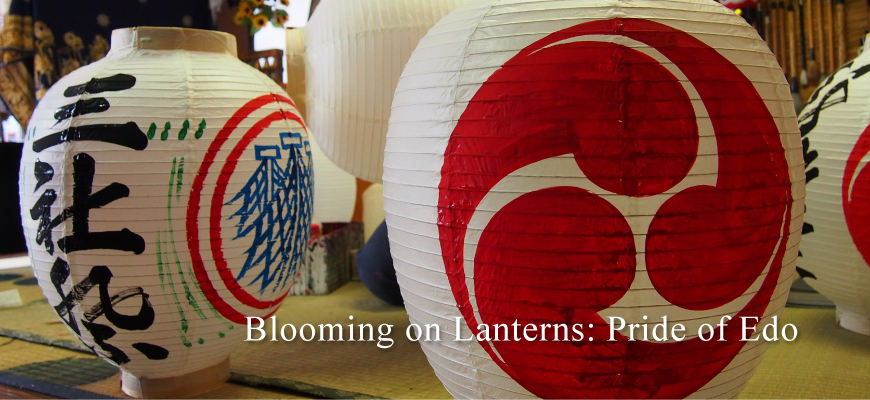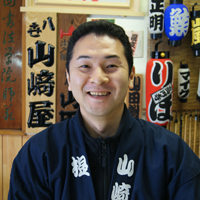
Norio Yamada
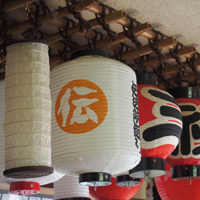
Types of lanterns vary according to their shapes, sizes and places from which they are hung, and pictures and calligraphy on them reflect craftsmen's personalities.
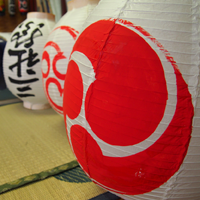
When we interviewed Yamada, he was making lanterns for Sanja Festival that is annually held in May. Designs of lanterns for Sanja Festival might change from year to year.
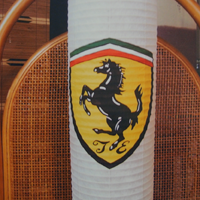
Yamada is also occasionally asked to depict companies' logos and English letters on lanterns, and actively works on incorporating modern designs in lanterns.
What are Edo-style hand-drawn lanterns?
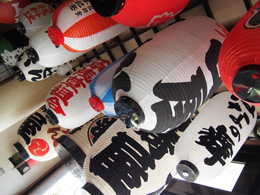
What do Edo-style hand-drawn lanterns mean to Yamada?
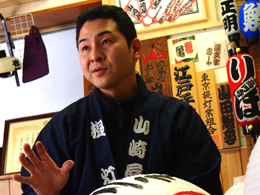
How did Yamada become an Edo-style hand-drawn lantern craftsman?
Could you tell me about the reason you became an Edo-style hand-drawn lantern craftsman?
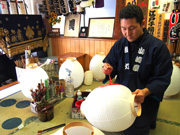
How did you learn to make lanterns?
There was an expert in making lanterns at a lantern maker in Asakusa. I was taught by that expert. Also, I was taught by a neighbor who belonged to "Tokyo Chochin Kumiai," or Tokyo lantern association. Our association also has a study group called "Chochin Kenkyu-kai," or association for the study of lanterns, where we can learn how to depict characters and pictures on lanterns. Although I started doing this job when I was about 20 years old, I received detailed instruction from superiors at the study group.
In taking over the family business, in addition to characters depicted on lanterns, I wanted to learn other characters. So I studied "Kantei-ryu Moji," or Kantei shool's characters, which are used for signboards and ranking charts of Kabuki performances, and "Yose Moji," or Yose characters, which are used for signboards and program boards of traditional Japanese comic storytelling. I have still studied those characters. I was also encouraged to attend a calligraphy school, so I have still studied at the school.
At which age did you become independent?
I became independent when I was 21 years old. Drawing on a lantern shaped like this is entirely different from writing on two-dimensional paper. So, at first, I was taught to "get accustomed to it and then learn it," or "be not afraid of depicting characters." Since my family has done this job generation after generation, there was a lot of work, but, at first, I took time to do this job at my own pace. Yes, I took a lot of time to complete each lantern.
Making of Edo-style hand-drawn lanterns
I heard that production of lanterns and depicting of characters on them are divided.
In the past, my family also did "Jibari," or process of pasting paper on lanterns, and depict characters on them. I think that there were few types of lanterns at that time, and that the passage of time was not as fast as of today, so the production of lanterns was possible. However, those processes are now completely divided.
Where do you deliver lanterns?
I mainly deliver lanterns to shrines, but some restaurants use lanterns as their signs. Since lanterns have also been used as good-luck tokens, some customers present lanterns on celebratory occasions, including a marriage ceremony, birth of a baby and construction of a new house. Also, some people personally hang lanterns in their rooms as decorations.
I have still happened to see red lanterns at taverns.
Yes. There are red lanterns. In the past, lanterns with candles put inside were used as lighting apparatus at taverns. At that time, black characters were typically depicted on white lanterns. I heard that one tavern was not flourishing, so its owner tried to make the tavern stand out by painting lanterns red. As a result, the tavern flourished well. Consequently, red lanterns came into widespread use in the Edo Period. I think red lanterns have still remained in Japanese sentiments.
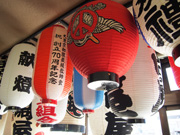
How many years has Yamazakiya been in business since the first generation?
It is about 300 years. Yamazakiya dates back to the Edo Period. My father also did this job, but he quit it because he was not cut out for it. Although he already passed away, since he was born as a son of the lantern maker, he worked for a lantern wholesaler after working as a white-collar worker. I think perhaps he liked lanterns because he liked to write characters and to draw pictures.
Edo-style hand-drawn lanterns
Are there some rules about calligraphic styles?
Although there is no school among Edo-style hand-drawn lantern craftsmen, characters that we depict are generically called "Edo-style characters." Most Edo-style hand-drawn lantern craftsmen take over their family businesses, so they are often taught how to depict by their fathers. So each lantern maker has its own style. Therefore, when I see lanterns in towns, in most cases, I can tell who made the lanterns.
Could you tell me about the history of Edo-style hand-drawn lanterns?
Lanterns were originally brought from China in the Muromachi Period. In Japan, lanterns were developed and spread as lighting apparatus in the Edo Period. The definition of a lantern is that it is a light device with a candle put inside and can be folded up compactly. Nowadays, many of lanterns used in taverns and restaurants do not have candles inside. However, basically, we refer to a light device which has a candle inside and can be folded up as a lantern. In the past, lanterns were mainly used in festivals. However, the range of their uses has gradually increased, and lanterns are now used in events held by large companies. Also, the number of customers who buy lanterns as gifts have increased. Therefore, although there are traditional styles of depicting characters on lanterns, some customers ask me to depict English letters on lanterns. In that case, I depict modernly designed letters on lanterns.
Do designs of lanterns differ according to regions?
Ordinary people cannot tell the differences, but designs, forms and sizes of lanterns are different. Especially pertaining to characters, as the term "Edo-style characters" remains, there has been the tradition of Edo-style characters since early times. The reason the characters have been handed down from generation to generation is that our predecessors studied a lot about characters. In that way, Edo-style characters have been cherished.
For example, there are talismans called "Senja-fuda," which are pasted on shrines and temples. In the Edo Period, those talismans were used as calling cards or mementos of visits to shrines or temples, on which people's names or stores' names were printed in a calligraphic style called "Edo-moji," or Edo-style characters. In the past, people spent many days to travel to the Kansai or Tohoku region. I think, at that time, people visited distant shrines and temples once in a lifetime, so they pasted Senja-fuda on shrines or temples as proofs that "they could safely come to this place." When I see Senja-fuda pasted on shrines and temples in provinces, I can figure out that people visited shrines and temples located in many parts of the country from Edo. However, when I visit shrines and temples in Tokyo, I rarely see Senja-fuda made by people from provinces. So, in the Edo Period, cultures of Senja-fuda and Edo-style characters were popular among people in Edo and its suburbs. I think that people living in Edo and its suburbs attached importance to characters.
Also, characters depicted by our predecessors are superb. Since people at that time used writing brushes since their childhood instead of using pencils and ballpoint pens, their calligraphy is different from that of us. So I think I am no match for those predecessors even if I spend the rest of my life on it.
Were early lanterns relatively simple?
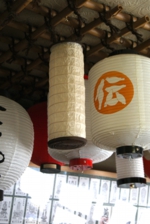
Manufacturing processes
Could you tell me about the manufacturing processes of Edo-style hand-drawn lanterns?
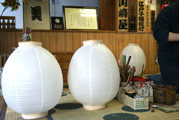
You depict characters and pictures on them, don't you?
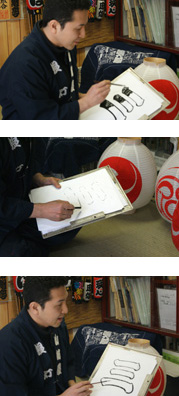
Just one character reflects a craftsman's individuality, doesn't it?
It reflects a craftsman's individuality. Some strongly depict very thick Edo-style characters, and others feminine, fine ones. Also, there are craftsmen who accurately depict diagram-like characters, of which height and width are equal in size, respectively. When I depict a Chinese character "San," there is no point in just depicting straight horizontal lines, so I depict slightly curved lines. For example, I give originality to a character by depicting it thinking that, if I wrote it with a large writing brush, what shape would it have? Also, since a candle is put inside a lantern, basically, characters on it should not be blur or transparent. However, there is an expression in which characters are intentionally blurred. In the case of the lantern that I am now making for Sanja Festival, since it is a festival, I express energy by intentionally leave light brush-strokes.
What points need special techniques?
Since a lantern is hung high, in most cases, it is seen from underneath. Although it slightly differs depending on each craftsman, in the case of vertical writing, spaces between lower characters on a lantern are shorter than those of upper characters. For example, if spaces between upper characters are 4 "Coma," a unit of character spacing, spaces between lower ones are 3 Coma. The most difficult thing is that, since pieces of paper are vertically pasted on a lantern as with a terrestrial globe, if I depict characters along joint lines of paper, widths of the characters narrow. For example, if I depict a character "Mon" for "Kaminari Mon" along joint lines of paper, a lower part of the character narrows. Therefore, I depict lower characters ignoring the joint lines so that the lower characters are wider than the upper characters. By doing so, characters in vertical writing look straight when they are looked up.
Tools
What kind of tools do you use?
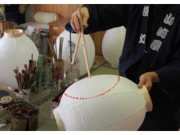
Pride as a craftsman
What is your pride as a craftsman?
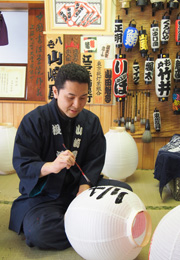

Norio Yamada

Types of lanterns vary according to their shapes, sizes and places from which they are hung, and pictures and calligraphy on them reflect craftsmen's personalities.

When we interviewed Yamada, he was making lanterns for Sanja Festival that is annually held in May. Designs of lanterns for Sanja Festival might change from year to year.

Yamada is also occasionally asked to depict companies' logos and English letters on lanterns, and actively works on incorporating modern designs in lanterns.
What are Edo-style hand-drawn lanterns?

It is said that the use of lanterns has begun in the Muromachi Period, and, in the Edo Period, lanterns were widely used as lighting apparatus. Originally, production of lanterns and depiction of characters were integrated, but they were divided in the Meiji Period. One of the characteristics of Edo-style hand-drawn lanterns is an expression in which legible Edo-style characters are sharply depicted.
What do Edo-style hand-drawn lanterns mean to Yamada?

There are thousands of family crests. There are also about 20 types of calligraphic styles. For this job, it might not enough to spend a lifetime to study it. I did not think deeply before I began to do this job. However, I felt it was hard after starting the job. No matter how hard I work, there is not enough time to master the job. Since our predecessors left many things, including calligraphy styles, ways to depict pictures, and Edo-style characters, I think our generation should also leave something new.






